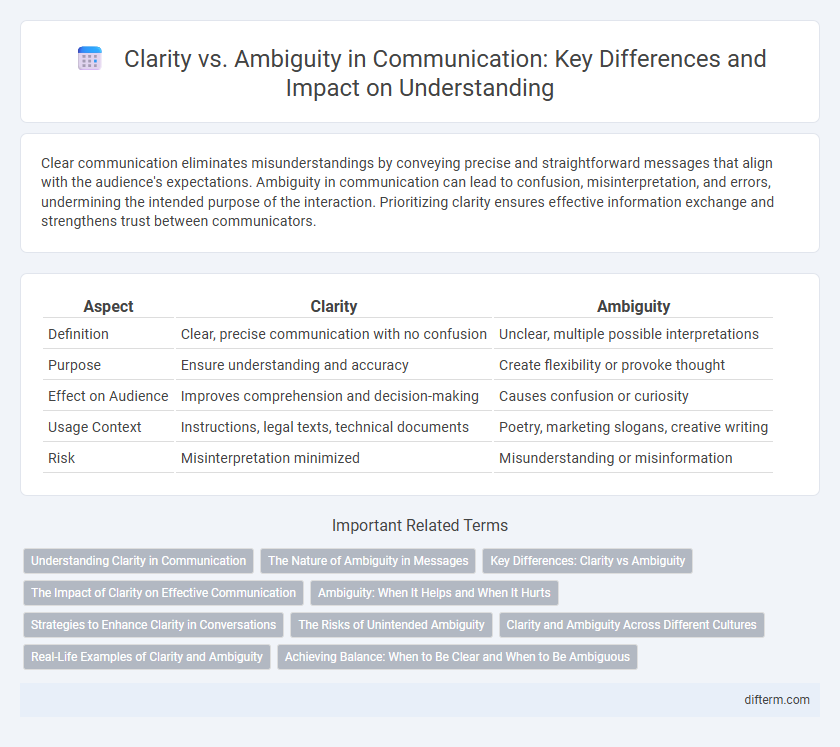Clear communication eliminates misunderstandings by conveying precise and straightforward messages that align with the audience's expectations. Ambiguity in communication can lead to confusion, misinterpretation, and errors, undermining the intended purpose of the interaction. Prioritizing clarity ensures effective information exchange and strengthens trust between communicators.
Table of Comparison
| Aspect | Clarity | Ambiguity |
|---|---|---|
| Definition | Clear, precise communication with no confusion | Unclear, multiple possible interpretations |
| Purpose | Ensure understanding and accuracy | Create flexibility or provoke thought |
| Effect on Audience | Improves comprehension and decision-making | Causes confusion or curiosity |
| Usage Context | Instructions, legal texts, technical documents | Poetry, marketing slogans, creative writing |
| Risk | Misinterpretation minimized | Misunderstanding or misinformation |
Understanding Clarity in Communication
Clarity in communication is essential for effective information exchange, minimizing misunderstandings by using precise language and well-structured messages. Clear communication enables the recipient to easily grasp the intended meaning, enhancing comprehension and reducing ambiguity. Prioritizing clarity improves collaboration, decision-making, and overall communication efficiency in both personal and professional contexts.
The Nature of Ambiguity in Messages
Ambiguity in messages arises from vague language, multiple meanings, or cultural differences, which can lead to misinterpretation and confusion in communication. Semantic ambiguity occurs when a word or phrase has multiple interpretations, while syntactic ambiguity involves unclear sentence structure. Understanding the nature of ambiguity helps communicators refine clarity by choosing precise vocabulary and context-specific expressions.
Key Differences: Clarity vs Ambiguity
Clarity in communication involves precise language and unambiguous messages that reduce misunderstandings, enhancing effective information exchange. Ambiguity occurs when statements have multiple interpretations, leading to confusion and potential miscommunication. Key differences include the intent to convey a single, clear meaning in clarity versus the presence of vague or double meanings in ambiguity.
The Impact of Clarity on Effective Communication
Clarity significantly enhances effective communication by reducing misunderstandings and ensuring the precise delivery of messages. Clear communication fosters trust and facilitates faster decision-making, critical in professional and personal interactions. Ambiguity often leads to confusion, errors, and diminished productivity, underscoring the importance of transparency and explicitness in verbal and written exchanges.
Ambiguity: When It Helps and When It Hurts
Ambiguity in communication can foster creativity and open interpretation, allowing diverse perspectives to flourish in complex discussions or advertising. However, persistent ambiguity often leads to misunderstandings, decreased trust, and inefficiency in organizational decision-making. Balancing clear messaging with strategic ambiguity enhances engagement while minimizing confusion.
Strategies to Enhance Clarity in Conversations
Effective communication relies heavily on clarity, achieved through strategies such as active listening, precise word choice, and structured messaging. Utilizing clear, concise language reduces the risk of misunderstandings and ensures the intended message is accurately conveyed. Implementing feedback loops and asking open-ended questions further enhances clarity by confirming comprehension and encouraging detailed responses.
The Risks of Unintended Ambiguity
Unintended ambiguity in communication can lead to misunderstandings, decreased trust, and costly errors in both personal and professional contexts. The risk of ambiguous messages includes misinterpretation of instructions, poor decision-making, and diminished team collaboration. Clear communication reduces these risks by ensuring that the intended meaning is accurately conveyed and understood.
Clarity and Ambiguity Across Different Cultures
Clarity in communication is essential for minimizing misunderstandings, especially across diverse cultural contexts where interpretations of the same message can vary significantly. In high-context cultures like Japan or Arab countries, ambiguity is often a strategic tool used to maintain harmony, while low-context cultures such as the United States or Germany prioritize explicit and clear messaging. Understanding these cultural differences in clarity versus ambiguity enhances effective cross-cultural communication and reduces potential conflicts.
Real-Life Examples of Clarity and Ambiguity
Clear communication in healthcare settings prevents medication errors and ensures patient safety, while ambiguous instructions in workplace emails often lead to missed deadlines and confusion. For example, a surgeon's precise verbal orders during an operation minimize risks, whereas unclear project guidelines can cause team members to work at cross purposes. Clarity in customer service scripts enhances satisfaction, contrasting sharply with ambiguous responses that frustrate and alienate clients.
Achieving Balance: When to Be Clear and When to Be Ambiguous
Achieving balance in communication requires recognizing when clarity enhances understanding and when ambiguity fosters openness or creativity. Clear messages minimize misunderstandings in critical instructions, while strategic ambiguity can encourage collaboration and diverse interpretations. Effective communicators adapt their approach based on context, audience, and desired outcomes to optimize message impact.
Clarity vs Ambiguity Infographic

 difterm.com
difterm.com